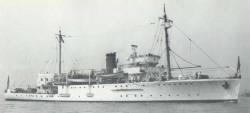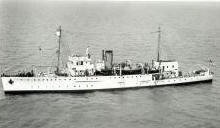










|
|

HMS Scott
|
Soon after his arrival
in office as Hydrographer Vice Admiral J A Edgell in 1932, turned
his attention to the replacement of the coal‑burning surveying fleet
of eight ships with a more modern one built for oil firing and for
echo sounding. It was also necessary to consider the employment of
the fleet in the war which was even now being seen as an
increasingly ominous cloud on the horizon. During 1933 it was agreed
that the fleet should remain at the established size of four smaller
ships for home waters and four larger ones abroad, but that only
four, two at home and two abroad, would be retained on surveying
tasks in wartime. It was proposed to replace the four Aberdares by
two vessels designed for surveying and two primarily designed as
minesweepers.
Both the small
surveying ships and the survey minesweeping sloops were built to the
same hull design as the Halcyon class minesweepers, of roughly 850
tons, which were entering service from 1934 onward. The small
surveying ships, named Franklin and SCOTT after explorers in
continuation of the line started by Beaufort and the other
Aberdares, had larger bridges than the minesweepers, a chartroom on
the upper deck aft, a full outfit of boats and a foremast stepped on
the forecastle in place of ‘A’ gun from which the beaconing derrick
was rigged. No provision was made in their fitting out for their
conversion to minesweepers.
Sloops
were to be designed primarily for minesweeping and simply fitted for
their survey role. No armament was to be fitted, though the Survey
Minesweeping Sloops were fitted for but not with the standard
Halcyon armament of 2 x 4-inch guns and small arms. A large
chartroom was built at the after end of the forecastle deck, and the
bridge was enlarged to make it more commodious for sextant angle
fixing. A large derrick was fitted on the forecastle for handling
survey beacons (floating marks like very large dan buoys).
The two survey minesweeping sloops, given the traditional small ship
names Jason and Gleaner, had a similar fit to Franklin and SCOTT
except that their foremast was stepped abaft the bridge like their
pure minesweeping sisters, with a stump mast for the derrick on the
forecastle which could be readily removed to allow the for’ard four
inch gun to be fitted rapidly. In fact all wiring and strengthening
was built into these two to allow for their speedy conversion to
full minesweeping configuration on the outbreak of war.
Source: EXTRACTS from:
Charts and Surveys in Peace and War – The History of the RN
Hydrographic Service 1919–1970 by Rear Admiral R O Morris CB
|
|
30.8.37 |
Caledon Shipbuilding and
Engineering Co Ltd, Dundee |
Laid down |
|
23.8.38 |
|
Launched |
|
23.2.39 |
|
Completed |
|
|
Ship adopted by Peeblesshire |
|
|
http://www.bbc.co.uk/dna/ww2/A3232379
MY LIFE
IN THE ROYAL NAVY
Frederick
Potter
I left school in 1936. Work was short at that time and the only
choice was between shipbuilding and coalmines. My lifelong friend
whose brother was under-manager of a coal mine helped me to get a
job in the mines in Silksworth, County Durham. I started there and
after six months my friend applied for entry into the Royal Navy.
Three months later he came home on leave and told me it was a good
life. So I made up my mind and applied to the Royal Naval
recruitment office to sit my General Knowledge test. I was advised
that I had passed and two weeks later my career in the Royal Navy
had begun. I was sent to HMS Pembroke in Chatham, Kent, along with
fifteen other boys. We underwent three months of basic training in
discipline, marching and gunnery and then joined a V+W class
destroyer, HMS Wanderer, for two weeks of sea training and
seamanship. We returned to Chatham as ordinary seamen (2nd Class).
The other boys and I were sent on ten days’ leave and returned to
Chatham for dispersal to various ships. We assembled in the drill
shed and were told by the drafting officer we were going to
Dundee in
Scotland to
join a survey ship, HMS SCOTT, which was being built by Caledon
shipbuilders. After builders' trials and sea trials, the ship was
commissioned on 23rd February, 1939.
We left
Chatham
to be fitted with surveying equipment and sailed from there three
weeks later to Scapa Flow in the Orkneys, where we witnessed the
floating of the last German battleship scuttled in 1918 as part of
the German Grand Fleet which was captured there.
After two
weeks in Orkney, we sailed for Aberdeen, Montrose, Arbroath and
Dundee. While we were staying in Dundee, tragedy happened. HMS
Torbay (Thetis?), one of the new subs on trials, sank in Liverpool
Bay with great loss of life. Two members of the crew had married
Dundee girls. The officer arranged a dance, with all the proceeds
going to next of kin. HMS SCOTT was the first ship to hold a dance
in the Empress Ballroom...
... Our ship sailed for Dundee from the River Forth, surveying Port
Edgar, Rosyth, Granton and Leith, and after completing these surveys
we sailed for Berwick, the river Tyne, Sunderland, Hull and then
down to Grimsby. I got seven days boiler- cleaning leave, after
which we sailed for Dover, arriving on Saturday. War was declared on
Sunday.
The ship sailed for Chatham and a number of the crew were discharged
to barracks. They wanted volunteers to become asdic (later sonar)
operators and I volunteered. I was sent to HMS Osprey for two
months’ training and qualified as an asdic operator.
|
Gleaner,
Jason and Franklin all started surveying in home waters in the
summer and autumn of 1938, to be joined by SCOTT in 1939.
Up to the outbreak of war SCOTT was employed on survey work in
connection with the proposal to lay a Channel Mine Barrage and,
during the first few months of the war, she was employed in
directing the minelayers in laying the Barrage.
|
|
HMS
SCOTT
Principal Surveys 1939 |
|
A D Day, W C Jenks
J Y G Torlesse |
Scotland, East Coast
Orkney Islands
England, East Coast
England, South Coast
|
Bass and Bell Rocks;
River Tay.
Entrances to Scapa Flow.
Harwich; Ramsgate; River
Medway
Portsmouth; Plymouth |


HMS Scott
|
Date of Arrival |
Place |
Date of Departure |
Orders, Remarks etc |
|
31.8.39 |
Off Ramsgate |
? |
31/8 Franklin is to take
over from SCOTT at Dover providing the positioning for the laying of
the Dover Strait mine barrage. |
|
1.9.39 |
Dover |
22.9.39 |
21/9 SCOTT is to proceed
to Sheerness for conversion to A/S vessel forthwith
|
|
22.9.39 |
Sheerness |
18.11.39 |
26/9 Taken in hand,
completes 11/11 approx
2/10 From C in C Nore:
SCOTT is due to complete conversion to A/S vessel on 11/11. Request
instructions regarding future employment.
3/11 On completion SCOTT
is to be sailed for Portland to work up. Subsequently 1st
A/S Striking Force Western Approaches.
7/11 Commissioned
SCOTT received
a single 3-inch AA gun in a bandstand for'ard of the foremast on the
forecastle and a varied fit of small arms. She kept the big chartroom
aft, but lost her mainmasts to topweight compensation. |
|
18.11.39 |
Sheerness |
27.11.39 |
18/11 Returned with gun
defect
20/11 From C in C Nore:
On passage to Portland leaves Sheerness on satisfactory completion of
sea trials a.m. 20/11
21/11 from A S Chatham:
SCOTT taken in hand 21/11. Date for completion dependant on result of
examination. Work in hand will prevent vessel sailing at 24 hours. |
|
28.11.39 |
Portland |
16.12.39 |
9/12 From F O i/c
Portland: SCOTT will be ready to sail 15/12 |
|
18.12.39 |
Port A |
17.1.40 |
Escorting Baltonia to
Scapa then proceeding Clyde
16/1 From C in C Western
Approaches: Request you will sail SCOTT for the Clyde as soon as
convenient and report number of boiler hours remaining |
|


